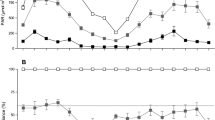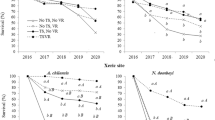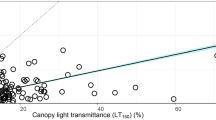Abstract
Plantations of exotic trees on areas where tropical forest has been clear-felled have been reported to facilitate regrowth of indigenous tree species. This so-called nurse- or shelter tree effect was investigated in a montane semihumid site in southern Ethiopia where plantations of Pinus patula and Eucalyptus saligna grow in close vicinity to the natural Podocarpus falcatus mixed forest. Physiological performance of P. falcatus saplings growing in the exotic and the natural forests was investigated over the year. Compared with the natural forest, photosynthetic carbon gain and growth of the saplings were significantly enhanced under Pinus patula while likewise retarded under Eucalyptus saligna. Diverging effects of the differently dense shelter canopies on the saplings could be traced to differences in the sub-canopy microclimates and particularly to the intensities and temporal distribution of photosynthetic active radiation (PAR). Moisture also played an important role for photosynthetic carbon gain: while the morning patterns of CO2 uptake were significantly correlated with the patterns of sunflecks, stomatal conductance was the determinant factor in the afternoon. Analysis of the photosynthetic efficiency of sunflecks revealed a lower quantum yield than the basic diffuse PAR intensity. Compared with a theoretically even distribution of the daily PAR, CO2 uptake under the real light climate was 70% under Pinus and in the natural forest, and 59% under Eucalyptus. Relating growth rates of Podocarpus saplings to photosynthesis the microclimate under Pinus was 2.5 times as effective as that in the natural forest and five times more effective than under Eucalyptus.






Similar content being viewed by others
Notes
Because of the repeated transfer of the second microclimate station between the Pinus and the Eucalyptus plantation and some problems with the sensor data for an extended series of days without precipitation, representing the dry season, are not available for the microclimate under the shelter of Eucalyptus trees.
References
Abate, A (2004) Biomass and Nutrient Studies of Selected Tree Species of Natural and Plantation Forests: Implications for a Sustainable Management of the Munessa-Shashemene Forest, Ethiopia. PhD Thesis, University of Bayreuth, Bayreuth
Adams MA, Grierson PF (2001) Stable isotopes at natural abundance in terrestrial plant ecology and ecophysiology: an update. Plant Biol 3:299–310
Asdak C, Jarvis PG, van Gardingen P, Frazer A (1998) Rainfall interception loss in unlogged and logged forest areas of Central Kalimantan, Indonesia. J Hydrol 206:237–244
Ashagrie Y, Zech W, Guggenberger G (2005) Transformation of a Podocarpus falcatus dominated natural forest into monoculture Eucalyptus globules plantation at Munessa, Ethiopia: Soil organic C, N and S dynamics in primary particle and aggregate-size fractions. Agric Ecosyst Environ 106:89–98
Ashton PMS, Gamage S, Gunatilleke I, Gunatilleke C (1998) Using Caribbean pine to establish a mixed plantation: testing effects of pine canopy removal on plantings of rain forest tree species. For Ecol Manage 106:211–222
Bazzaz F (1991) Regeneration of tropical forests: physiological responses of pioneer and secondary species. In: Gomez-Pompa A, Whitmore T, Hadley M (eds) Rainforest regeneration and management. Parthenon Publishing, Paris, pp 91–118
Binkley D, Resh SC (1998) Rapid changes in soils following Eucalyptus afforestation in Hawaii. Soil Sci Soc Am 63:222–225
Brasell HM, Sinclair MDF (1983) Elements returned to forest floor in two rainforest and three plantation plots in tropical Australia. J Ecol 71:367–378
Canham CD, Finzi AC, Pacala SW, Burbank DH (1994) Causes and consequences of resource hetereogeneity in forests: interspecific variations in light transmission by canopy trees. Can J For Res 24:337–349
Chaffey DR (1980) South-west Ethiopia forest inventory project: and inventory of forest at Munessa and Sheshamene. Ministry of Overseas Development, Land Resource Division, Project Report 29, London
Chazdon RL (1986) Light variation and carbon gain in rainforest understorey palms. J Ecol 74:995–1012
Chazdon RL, Fetcher N (1984) Photosynthetic light environments in a lowland tropical rain forest in Costa Rica. J Ecol 72:553–564
Chazdon RL, Pearcy RW (1986) Photosynthesis responses to light variation in rainforest species II. Carbon gain and photosynthetic efficiency during lightflecks. Oecologia (Berl.) 69:524–531
Comstock JP (2002) Hydraulic and chemical signalling in the control of stomatal conductance and transpiration. J Exp Bot 53:195–200
Crockford RH, Richardson DP (2000) Partitioning of rainfall into throughfall, stem flow and interception: effects of forest type, ground cover and climate. Hydrol Process 14:2903–2920
Cusack D, Montagnini F (2004) The role of native species plantations in recovery of understorey woody diversity in degraded pasturelands of Costa Rica. For Ecol Manage 188:1–15
De Lucia E, Whitehead D, Clearwater MJ (2003) The relative limitation of photosynthesis by mesophyll conductance in co-occurring species in a temperate rainforest dominated by the conifer Dacrydium cupressinum. Funct Plant Biol 30:1197–1204
FAO (2003) State of the World’s Forests 2003. Food and Agriculture Organization of the United Nations, Rome, p 151
FAO (2006) Global Forest Assessment 2005. FAO Forestry 147, Rome 2006
Farquhar GD, Ehleringer JR, Hubick KT (1989a) Carbon isotope discrimination and photosynthesis. Annu Rev Plant Physiol Plant Mol Biol 40:503–536
Farquhar GD, Hubick KT, Condon AG, Richards RA (1989b) Carbon isotope fractionation and plant-water use efficiency. In: Rundel PW, Ehleringer JER, Nagy KA (eds) Stable isotopes in ecological research. Springer, New York, pp 21–40
Fernandez C, Lelong B, Vila B, Mévy J-P, Robles C, Greff S, Dupouyet S, Bousquet-Mélou A (2006) Potential allelopathic effect of Pinus halepensis in the secondary succession: an experimental approach. Chemoecology 16:97–105
Fetene M, Beck EH (2004) Water relations of indigenous versus exotic tree species, growing at the same site in a tropical montane forest in southern Ethiopia. Trees 18:428–435
Feyera S, Beck E, Lüttge U (2002) Exotic trees as nurse-trees for the generation of a natural tropical forest. Trees 16:245–249
Fimbel RA, Fimbel CC (1996) The role of exotic conifer plantations in rehabilitating degraded tropical forest lands: A case study from the Kibale Forest in Uganda. For Ecol Manage 81:215–226
Flexas J, Ribas-Carbó M, Diaz-Espejo A, Galmés J, Medrano H (2008) Mesophyll conductance to CO2: current knowledge and future prospects. Plant Cell Environ 31:602–621
Freier KP, Glaser B, Zech W (2010) Mathematical modelling of soil carbon turnover in natural Podocarpus forest and Eucalyptus plantation in Ethiopia using compound specific δ13C analysis. Global Change Biol 16:1487–1502
Friis I, Friis Ib (1992) Forests and forest trees of northeast tropical Africa: their natural habitats and distribution patterns in Ethiopia. Djibouti and Somalia, Kew Bulletin
Fritzsche F, Asferachew A, Fetene M, Beck E, Weise S, Guggenberger G (2006) Soil-plant hydrology of indigenous and exotic trees in an Ethiopian montane forest. Tree Physiol 26:1043–1054
Granier A (1987) Evaluation of transpiration in a Douglas fir stand by means of sap flow measurements. Tree Physiol 3:309–320
Granier A, Loustau D (1994) Measuring and modelling the transpiration of a maritime pine canopy from sap flow data. Agric For Meteor 51:309–319
Guariguata MR, Rheingans R, Montagnini E (1995) Early woody invasion under tree plantations in Costa Rica: Implications for forest restoration. Restor Ecol 3:223–252
Guo LB, Gifford RM (2002) Soil carbon stocks and land use change: a meta analysis. Global Change Biol 8:345–360
Haggar JP, Wightman K, Fisher R (1997) The potential of plantations to foster woody regeneration within a deforested landscape in lowland Costa Rica. For Ecol Manage 99:55–64
Harrington RA, Ewel JJ (1997) Invasibility of tree plantations by native and non-indigenous plant species in Hawaii. For Ecol Manage 99:153–162
Healey SP, Robert IG (2003) The effect of a teak (Tectona grandis) plantation on the establishment of native species in an abandoned pasture in Costa Rica. For Ecol Manage 176:497–507
Huber A, Iroumé A, Bathurst J (2007) Effect of Pinus radiate plantations on water balance in Chile. Hydrol Process 22:142–148
Kao WY, Chiu YS, Chen WH (2000) Vertical profiles of CO2 concentration and d13C values in a subalpine forest of Taiwan. Bot Bull Acad Sin 41:213–218
Kasenene JM (2007) Impact of exotic plantations and harvesting methods on the regeneration of indigenous tree species in Kibale forest, Uganda. Afr J Ecol 45:41–47
Keenan R, Lamb D, Woldring O, Irvine T, Jensen R (1997) Restoration of plant biodiversity beneath tropical tree plantations in northern Australia. For Ecol Manage 99:117–131
Kodama N, Barnard RL, Salmon Y, Weston C, Ferrio JP, Holst J, Werner RA, Saurer M, Rennenberg H, Buchmann N, Gessler A (2008) Temporal dynamics of the carbon isotope composition in a Pinus sylvestris stand: from newly assimilated organic carbon to respired carbon dioxide. Oecologia 156:737–750
Küppers M, Timm H, Orth F, Stegemann J, Stöber R, Schneider H, Paliwal K, Karunaichamy KSTK, Ortiz R (1996) Effects of light environment and successional status on lightfleck use by understory trees of temperate and tropical forests. Tree Physiol 16:69–80
Larcher W (2001) Ökophysiologie der Pflanzen. Verlag Eugen Ulmer, Stuttgart, p 126
Leakey ADB, Scholes JD, Press MC (2004) Physiological and ecological significance of sunflecks for dipterocarp seedlings. J Exp Bot 56:469–482
Lemenih M (2006) Expediting ecological restoration with the help of foster tree plantations in Ethiopia. J Drylands 1:72–84
Lemenih M, Olsson M, Karltun E (2004) Comparison of soil attributes under Cupressus lusitanica and Eucalyptus saligna established on abandoned farmlands with continuously cropped farmlands and natural forest in Ethiopia. For Ecol Manage 195:57–67
Lisanework N, Michelsen A (1993) Allelopathy in agroforestry systems: the effects of leaf extracts of Cupressus lucitanica and three Eucalyptus spp on four Ethiopian crops. Agrofor Syst 21:63–74
Little C, Lara A, McPhee J, Urrutia R (2009) Revealing the impact of forest exotic plantations on water yield in large-scale watersheds in South-Central Chile. J Hydrol 374:162–170
Lugo AE (1992) Comparison of tropical tree plantations with secondary forests of similar age. Ecol Monogr 62:1–41
Lüttge U, Berg A, Fetene M, Nauke P, Peter D, Beck E (2003) Comparative characterization of photosynthetic performance and water relations of native trees and exotic plantation trees in an Ethiopian forest. Trees 17:40–50
Lüttge U, Escher P, Paluch R, Pfanz H, Wittmann C, Rennenberg H, Rakowski K (2011) Variability of photosynthetic capacity and water relations of Pinus sylvestris L. in the field. Biol Planta 55:90–98
Michelsen A, Lisanework N, Ib Friis (1993) Impacts of tree plantations in the Ethiopian highland on soil fertility, shoot and root growth, nutrient utilization and mycorrhizal colonization. For Ecol Manage 61:299–324
Montagnini F (2001) Strategies for the recovery of degraded ecosystems: experiences from Latin America. Intersciencia 26:498–503
Müller-Hohenstein K, Abate A (2004) Rain forest margins and their dynamics in south-east Ethiopia. In: Gerold G, Fremerey M, Gudhardja U (eds) Use nature conservation and the stability of rainforest margins in southeast Asia Environmental Science. Springer, Berlin, pp 217–238
Negash L (1995) Indigenous trees of Ethiopia: Biology, uses and propagation techniques. SLU Reprocentralen Umeå, Sweden, p 284
Oberhauser U (1997) Secondary forest regeneration beneath pine (Pinus kesiya) plantations in the northern Thai highlands: a chronosequence study. For Ecol Manage 99:171–183
Otsamo R (1998) Effect of nurse tree species on early growth of Anisoptera marginata Korth. (Dipterocarpaceae) on an Imperata cylindrica (L.) Beauv. Grassland site in South Kalimantan, Indonesia. For Eco Manage 105:303–311
Parrotta JA (1992) The role of plantation forests in rehabilitating degraded tropical ecosystems. Agric Ecosyst Environ 41:115–133
Parrotta JA (1993) Secondary forest regeneration on degraded tropical lands: The role of Plantations as “fosterecosystems”. In: Lieth H, Lohmann M (eds) Restoration of tropical forest ecosystems. Kluwer, Dortrecht, pp 63–73
Parrotta JA (1995) Influence of overstory composition on understory colonization by native species in plantations on a degraded tropical site. J Veg Sci 6:627–636
Parrotta JA, Turnbull JW, Jones N (1997) Catalyzing native forest regeneration on degraded tropical lands. For Ecol Manage 99:1–7
Pearcy RW, Pfitsch WA (1994) Consequences of sunflecks for photosynthesis and growth of forest understory plants. In: Schulze ED, Caldwell MM (eds) Ecophysiology of photosynthesis. Springer, Berlin, pp 343–359
Pearcy RW, Chazdon RL, Gross LJ, Mott KA (1994) Photosynthetic utilization of sunflecks: a temporally patchy resource on a time scale of seconds to minutes. In: Caldwell MM, Pearcy RW (eds) Exploitation of environmental heterogeneity by plants–Ecophysiological processes above- and belowground. Academic Press San Diego, New York, pp 175–208
Pfitsch WA, Pearcy RW (1989) Daily carbon gain by Adenocaulon bicolour (Asteraceae), a redwood forest understory herb, in relation to its light environment. Oecologia 80:465–470
Pohjonen V, Pukkala T (1990) Eucalyptus globulus in Ethiopian forestry. For Ecol Manage 36:19–31
Poore MED, Fries C (1985) The ecological effects of Eucalyptus. Forestry Paper 59. United Nations Food and Agriculture Organization, Rome, p 87
Rao CRN (1984) Photosynthetic active components of global solar radiation: measurements and model computations. Arch Met Geoph Biocl Ser B 34:353–364
Rodgers A (1992) Ethiopia. In: Sayer JA, Harcocurt CS, Collins NM (eds) The conservation atlas of tropical forests: Africa. IUCN, New York, pp 148–160
Roehle H (1986) Vergleichende Untersuchungen zur Ermittlung der Genauigkeit bei der Ablotung von Kronenradien mit dem Dachlot und durch senkrechtes Anvisieren des Kronenrandes (Hochblick-Messung). Forstarchiv 2:67–71
Russ GW (1945) Reports on Ethiopian Forests. Compiled by Wolde-Michael Kelecha, 1979. Addis Abeba, p 215
Schulze E-D (1993) Soil water deficits and atmospheric humidity as environmental signals. In: Smith JAC, Griffith H (eds) Water deficits. Bios Scientific Publ, Oxford, pp 129–145
Selwyn MA, Ganesan R (2009) Evaluating the potential role of Eucalyptus plantations in the regeneration of native trees in southern Ghats, India. Trop Ecol 50:173–189
Senbeta F, Teketay D, Näslund B-A (2002) Native woody species regeneration in exotic tree plantations at Munessa-Shashemene Forest, southern Ethiopia. New For 24:131–145
Solomon D, Fritzsche F, Tekalign M, Lehmann J, Zech W (2002) Soil organic matter composition in the subhumid Ethiopian highlands as influenced by deforestation and agricultural management. Soil Science Society America Journal 66:68–82
Teketay D (1997) Seedling populations and regeneration of woody species in dry Afromontane forest of Ethiopia. For Ecol Manage 98:149–165
Teketay D, Granstrom A (1995) Soil seed banks in dry Afromontane forests of Ethiopia. J Veg Sci 6:777–786
Tesfaye G (2008) Ecology of regeneration and phenology of seven indigenous tree species in a dry Afromontane forest of Ethiopia. PhD thesis, Addis Ababa University, Addis Ababa, Ethiopia
Tesfaye G, Teketay D, Fetene M (2002) Regeneration of fourteen tree species in Harenna forest, southeastern Ethiopia. Flora 197:461–467
Tesfaye G, Teketay D, Fetene M, Beck E (2010) Regeneration of seven indigenous tree species in a dry Afromontane forest, southern Ethiopia. Flora 205:135–143
Valladares F, Niinemets Ü (2008) Shade tolerance, a key plant feature of complex nature and consequences. Annu Rev Ecol Evol Syst 39:237–257
Valladares F, Mitchell TA, Pearcy RW (1997) Photosynthetic responses to dynamic light under field conditions in six tropical rainforest shrub occurring along a light gradient. Oecologia 111:505–514
Von Breitenbach F (1962) National forestry development planning: A feasibility and priority study on the example of Ethiopia. Ethiopia For Rev 3(4):41–68
Weber JA, JurikTW TenhunenJD, Gates DM (1985) Analysis of gas exchange in seedlings of Acer saccharum: integration of field and laboratory studies. Oecologia 65:338–347
White F (1983) The vegetation of Africa: a descriptive memoir to accompany the UNESCO/AETFAT/UNSO vegetation map of Africa. UNESCO, Paris
Whitmore T (1996) A review of some aspects of tropical rainforest seedling ecology with suggestions for further enquiry. In: Swaine M (ed) The ecology of tropical forest tree seedlings. Parthenon Publishing, Paris, pp 3–9
Yirdaw E, Luukkanen O (2003) Indigenous woody species diversity in Eucalyptus globulus Labill. ssp. globulus plantations in the Ethiopian highlands. Mt Res Dev 21:184–191
Acknowledgments
The work was supported by grant Be 473/35-2 from the German Research Foundation in the scope of the joint programme (Regeneration in an Ethiopian montane forest with special emphasis on tree biology and nurse-tree functions). Thanks are due to Prof. Dr. G. Gebauer from the Bayreuth Centre for Ecology and environmental Research (BAYCEER) for δ13C analysis. Administrative support and effective coordination of the project by Dr. Asferachew Abate, Addis Ababa is gratefully acknowledged.
Author information
Authors and Affiliations
Corresponding author
Additional information
Communicated by U. Luettge.
Rights and permissions
About this article
Cite this article
Strobl, S., Fetene, M. & Beck, E.H. Analysis of the “shelter tree-effect” of natural and exotic forest canopies on the growth of young Podocarpus falcatus trees in southern Ethiopia. Trees 25, 769–783 (2011). https://doi.org/10.1007/s00468-011-0554-x
Received:
Revised:
Accepted:
Published:
Issue Date:
DOI: https://doi.org/10.1007/s00468-011-0554-x




